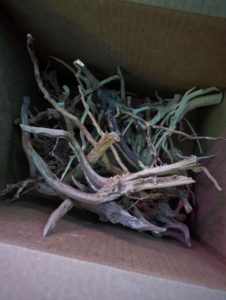Driftwood, with its weathered charm and unique texture, has become a popular choice among aquarists and enthusiasts in creating stunning aquatic environments. However, one of the key considerations when using driftwood in an aquarium is its tendency to release tannins into the water. In this blog post, we’ll explore the most common types of driftwood and discuss their likeliness to release tannins, enabling you to make informed choices when selecting driftwood for your aquarium.
- Mopani Wood: Mopani wood, originating from Africa, is a highly sought-after type of driftwood. It is known for its intricate twisting patterns and rich, dark brown color. Mopani wood has a moderate tendency to release tannins, which can lead to a slight yellowish tint in the water. However, the amount of tannins released decreases over time with proper soaking and preparation.
- Malaysian Driftwood: Malaysian driftwood, as the name suggests, comes from the rivers and swamps of Malaysia. It is favored for its intricate branching structures and lighter coloration. Malaysian driftwood has a relatively high likelihood of releasing tannins, which can result in a significant discoloration of the water. Soaking and regular water changes are recommended to minimize the impact.

- Spider Wood: Spider wood, also known as Azalea wood or Indian Almond wood, is native to Asia. Its uniquely shaped branches resemble spider legs, hence the name. Spider wood is generally considered low in tannin release, making it a popular choice for aquarists who want to minimize discoloration. It often possesses a beautiful light brown or reddish hue and adds an artistic touch to any aquarium.
- Bogwood: Bogwood is found in freshwater bogs and marshes, typically in Europe. It is one of the most common types of driftwood used in aquariums due to its availability and attractive features. Bogwood has a variable tendency to release tannins, with some pieces having a minimal impact on water coloration, while others can impart a more noticeable yellow or brown tint. Soaking and regular water changes are essential to mitigate tannin release.
- Grapevine Wood: Grapevine wood, as the name implies, is obtained from the vineyards and is a byproduct of the wine industry. It features intricate twists and turns, creating a visually appealing look in an aquarium. Grapevine wood has a low to moderate tendency to release tannins, depending on the specific piece. Soaking and monitoring the water quality are crucial for managing any tannin leaching.
Conclusion: When selecting driftwood for your aquarium, it’s important to consider the likelihood of tannin release and how it may affect the aesthetics and water chemistry of your tank. While many types of driftwood release tannins to some extent, proper soaking, water changes, and maintenance can help minimize their impact. Ultimately, your choice of driftwood should align with your preferences and the specific needs of your aquatic environment. With the right approach, driftwood can add a natural and captivating element to your aquarium while maintaining the health and well-being of your aquatic inhabitants.
**AI Prompt write a blog post about the most common types of driftwood and their likeliness to release tannins**